Fifty-five years after it first wowed the crowds at the Farnborough, the Avro Vulcan is on the verge of an air show comeback - if restorers can raise more cash
More than five decades ago, the huge Avro Type 698 delta-winged bomber - later named "Vulcan" - made one of the most dramatic Farnborough air show debuts ever. Funding permitting, the aircraft's direct descendent Vulcan B2 XH558 will be on display at the 2008 show, after one of the most remarkable restoration programmes in aviation history.
When the all-white prototype of the Avro V-bomber that would be named after the Roman god of fire made its display debut at the second day of the 1952 Farnborough show, it had completed its first flight less than 72h earlier - a feat unheard of in the modern era. From that moment, the Vulcan was destined to leave an indomitable mark on air show crowds for a generation, and if the Bruntingthorpe-based Vulcan Operating Company (VOC) can secure the funds, then the V-bomber will be wowing spectators at air shows across the UK in 2008.
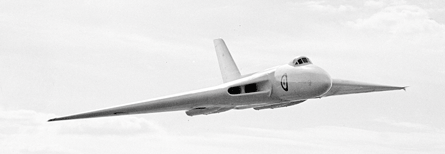 |
|---|
| The Vulcan prototype made its show debut at Farnborough in 1952, three days after its first flight... |
Vulcan XH558 (G-VLCN) made its first flight on 18 October 2007 after lengthy restoration costing £6 million ($12 million) - double the original estimate. Its positioning to the Leicestershire airfield from its RAF Waddington base in March 1993 had been the last time any Vulcan had flown. The restoration to return the aircraft to flying status - undertaken in conjunction with Marshall Aerospace and funded by donations, sponsorship and £2.7 million from the Heritage Lottery Fund (HLF) - began in late 1999.
Eight years on, and following October's successful first test flight - all that remains between XH558 and its return to the air show circuit is its "BCAR A8-20 Permit To Fly" - and a trifling £100,000, says VOC project engineering director Andrew Edmondson. "Our expectation is that we need to complete two 3h air tests, and then make the submission through Marshalls for the A8-20 permit required to fly at air shows. We're looking for £100,000 to complete this part of the project and we're in discussions with potential sponsors, but nothing is finalised," he says.
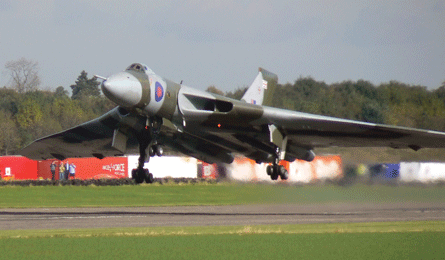 |
|---|
| ...now, funding permitting, the restored XH558 should make a triumphant return to the air show circuit in 2008 |
Funding target
"It is crucial we have the funding in January," says Edmondson, as the aim is to undertake these remaining test flights and complete the documentation required for the permit to fly by the end of March. "This would allow us to hand the aircraft over to operations and give them six weeks to prepare the presentation of the aircraft prior to the start of the air show season in May," he says.
VOC, formed in 1999 to oversee the restoration to flight of the Vulcan, is headed by former Cisco executive Dr Robert Pleming, who has spearheaded the search for funding. The company employs 14 permanent staff at Bruntingthorpe, including five engineers led by crew chief Kevin "Taff" Stone. Additional staff, such as consultants, flightcrew and volunteers, assist as required.
A provisional list of 17 air shows at which the Vulcan could participate in 2008 has been prepared, with venues "as far north as RAF Leuchars [Scotland] and as far west as RNAS Culdrose [in Cornwall]", says Edmondson. "Farnborough is also on the list," he adds.
Delta force
One of the Vulcan's most celebrated attributes is its huge, 368m2 (3,964ft2), delta wing -dubbed "aluminum overcast" by the US Air Force - and it was to be the wing that almost terminated the return to flight. "In early 2007, we discovered that the stringers above the undercarriage bays needed rectification work," says Edmondson.
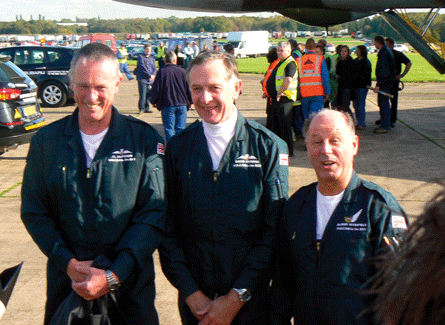 |
|---|
| Happy first flight crew (left to right): Sqn Ldrs Al McDicken, David Thomas and Barry Masefield |
This unexpected problem - which required the upper wing skins to be peeled back and the replacement of 14m (45ft) of wing-stringer and 20,000 rivets - consumed not only time but also £250,000. "That killed our contingency fund," he adds.
The Vulcan's hoped-for participation in a Falklands War 25th anniversary fly-past in June 2007 did not happen, but work continued apace to get the aircraft airborne before the year closed. Engine runs began in August, and on 17 October the aircraft was carrying out slow- and high-speed taxi runs in preparation for the next day's test flight.
The return-to-flight test sortie went "brilliantly", says Sqn Ldr Al McDicken who was in the left hand Martin Baker ejection seat next to VOC chief pilot Sqn Ldr David Thomas.
Accompanying the two experienced Vulcan pilots for the 34min flight on 18 October at the rear station was air electronics operator Sqn Ldr Barry Masefield - who like Thomas was on board XH558 for its delivery flight to Bruntingthorpe in 1993.
Tanker programme
McDicken, being a qualified test pilot, was designated to fly the sortie to comply with UK Civil Aviation Authority requirements. He last flew a Vulcan 25 years ago, when he was involved in the flight-test programme for the K2 tanker conversion programme with BAe at Woodford. "I found it all came back to me very quickly," he says.
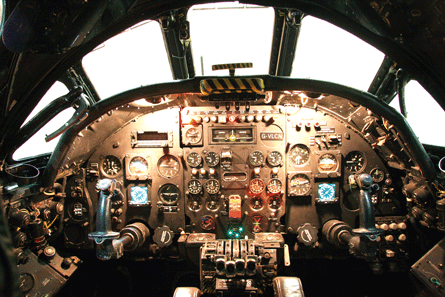 |
|---|
| The Vulcan has a cosy, fighter-like cockpit with the two pilots seated side-by-side |
XH558's take-off weight for test flight was "a little less than 130,000lb [58t] with around 28,000lb of fuel", says McDicken.
Masefield made the checklist prompts, while for the take-off run Thomas called out the speeds: "80kt [148km/h]" (the cue for airspeed indicators check) and at 135kt: "rotate". With the four Rolls-Royce Olympus 202s providing a combined 66,000lb thrust (294N), XH558 was airborne after a ground run of just 550m. "She was so eager to fly," says McDicken. So eager in fact, that the V-Bomber rapidly accelerated past the target initial climb value of 148kt to 180kt.
"I was pulling the stick back and back to contain the speed. The attitude was 20 degrees to 25 degrees. And when I looked at the VSI it was pinned at the maximum value of 4,000ft/min. We reached our initial height of 2,000ft very rapidly and I throttled back to level off."
McDicken flew the Vulcan out to the east, the undercarriage was retracted and a short test programme undertaken at 3,500ft, including a handling check. "We flew a few turns at approach speeds." Thomas then took control of XH558 to re-familiarise himself with the delta-jet's handling after 14 years absence.
Ballast
During XH558's restoration and overhaul, some 6t of unnecessary equipment and wiring, the legacy of the Vulcan's days as an offensive aircraft, were removed.
However, around 2t of ballast was then required to bring the aircraft's centre of gravity back within limits, says Stone. "We installed steel into the nose, which has been dubbed 'Red Square' or 'Red Slab' along the lines of 'Red Shrimp' jamming equipment once fitted to the Vulcan." The ballast takes the Vulcan's all-up weight - less fuel - to around 46t, says Edmondson. "The maximum take-off weight we'll operate to is 144,400lb [66t]."
McDicken says that the modifications had had no impact on the Vulcan's handling, and with the in-flight checks complete, the crew re-extended the undercarriage and the Vulcan turned back to Bruntingthorpe for a 500ft fly-by, followed by landing. "We flew the pattern at 155kt. Our approach speed was 135kt, reducing to 125kt at the threshold," says McDicken.
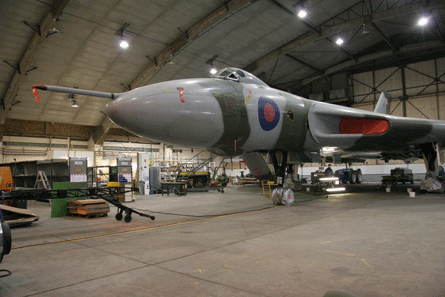 |
|---|
| Lady in waiting: XH558 is under care and maintenance at Bruntingthorpe ahead of the hoped-for flight-test programme to secure the permit to fly |
After a smooth touchdown, the brake-chute was deployed and it was mission accomplished for VOC. "I felt very lucky and privileged to have been involved," says McDicken, who is now looking ahead to the rest of test programme, expected to involve two 3h flights, one of which will require a landing away at an airfield such as Waddington to perform compass swings. "During the next test we'll complete the flight envelope and handling checks. The aircraft has a much reduced flight envelope - the maximum we'll go to is a speed of 300kt and an altitude of 17-18,000ft," he says.
The third test flight will focus on clearing upgraded avionics equipment, such as the new altimeters and LCD compasses (replacing obsolete units), and the Garmin navigation system. One of the flights may carry a fourth crew member in the form of a Marshall Aerospace test pilot acting as an observer.
Once the aircraft receives its permit, the air show programme will be ready to move into full swing with the ongoing support of Marshalls. VOC will need £1.6 million to fund the Vulcan through each air show display season, but Edmondson says that this is "a gross figure" and does not allow for the contribution of supporters such as BP UK which supplies fuel at "an acceptable rate" and Subaru, which provides support vehicles.
In all, XH558 has around 170 sponsors and supporters, including original equipment manufacturers and suppliers who have undertaken work in kind or at cost, but more help is needed.
Place in history
The Vulcan's historical significance as a key element of the UK's deterrent during the Cold War - its original role was to deliver the Blue Steel stand-off nuclear missile - was central to the successful bid for HLF support. "The aim is to educate and inspire," says Edmondson. This has involved linking up with local schools and county councils to incorporate the Vulcan in the curriculum and enable children to get up close to the aircraft. "A big part of this will be to present the aircraft at air shows," he adds.
VOC estimates that the Vulcan should remain airworthy for 10 years, but it is the availability of overhauled Olympus engines rather than any issues with the airframe that will determine the aircraft's life. "We can manage the fatigue of the airframe, but we have last eight serviceable Olympus engines [for the Vulcan] and no overhaul capability exists," says Edmondson.
The engine life has been calculated from the RAF's experience when it operated the Vulcan, and is being verified by on-board equipment that will monitor engine cycles during operation. VOC hopes to gain additional life from the engines by more careful use of the engines during flights than when in front line service and spares availability was not an issue.
And all being well, less than six months from now McDicken, Thomas, Masefield and colleagues will be putting XH558 through its paces at air shows across the UK.
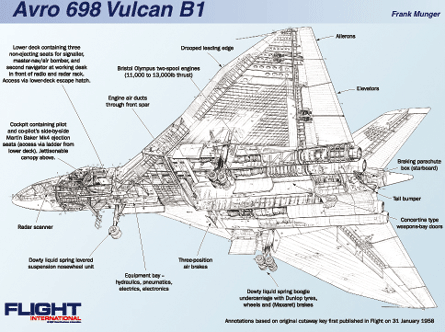
Related links:
- The Vulcan project needs £100,000 to complete flight test programme
- The Vulcan restoration project special
- The Vulcan XH558 first flight after restoration in 2007
- Vulcan To The Sky Trust
Click here to see Flight's Vulcan cutaway
Flight's collection of Vulcan pictures...
Source: Flight International
















